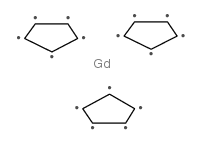1272-21-5
| Name | tris(cyclopentadienyl)gadolinium |
|---|---|
| Synonyms |
Tris(cyclopentadienyl)gadolinium(III)
EINECS 215-046-9 Tris(cyclopentadienyl)gadolinium (III) (-Gd) (REO) Tris(cyclopentadienyl)gadolinium(III) (REO) tris(eta5-cyclopenta-2,4-dien-1-yl)gadolinium Tris(cyclopentadienyl)gadolinium ( Gd) (REO) MFCD00145476 |
| Boiling Point | 41.5ºC at 760 mmHg |
|---|---|
| Melting Point | 295ºC |
| Molecular Formula | C15H15Gd |
| Molecular Weight | 352.53000 |
| Exact Mass | 353.04100 |
| LogP | 3.06450 |
| Vapour Pressure | 418mmHg at 25°C |
|
Section 1: Product Identification Chemical Name:Tris(cyclopentadienyl)gadolinium (99.9%-Gd) (REO) CAS Registry Number:1272-21-5 Formula:(C5H5)3Gd EINECS Number:none Chemical Family:organometallic complexes Synonym:None
Section 2: Composition and Information on Ingredients IngredientCAS NumberPercentACGIH (TWA)OSHA (PEL) Title compound1272-21-5100%no datano data Section 3: Hazards Identification Emergency Overview:May be irritating to skin, eyes and mucous membranes. Primary Routes of Exposure:Ingestion, eyes Eye Contact:May cause slight to mild irritation of the eyes Skin Contact:May cause slight to mild irritation of the skin. Inhalation:May be irritating to the nose, mucous membranes and respiratory tract. Ingestion:Ingestion may lead to vomiting, and diarrhea. Acute Health Affects:May be irritating to skin, eyes and respiratory tract. Chronic Health Affects:No information available on long-term chronic effects. NTP:No IARC:No OSHA:No SECTION 4: First Aid Measures Immediately flush the eyes with copious amounts of water for at least 10-15 minutes. A victim may need Eye Exposure: assistance in keeping their eye lids open. Get immediate medical attention. Wash the affected area with water. Remove contaminated clothes if necessary. Seek medical assistance if Skin Exposure: irritation persists. Remove the victim to fresh air. Closely monitor the victim for signs of respiratory problems, such as difficulty Inhalation: in breathing, coughing, wheezing, or pain. In such cases seek immediate medical assistance. Seek medical attention immediately. Keep the victim calm. Give the victim water (only if conscious). Induce Ingestion: vomiting only if directed by medical personnel. SECTION 5: Fire Fighting Measures Flash Point:none Autoignition Temperature:none Explosion Limits:none Extinguishing Medium:carbon dioxide, foam or dry powder If this product is involved in a fire, fire fighters should be equipped with a NIOSH approved positive pressure Special Fire Fighting Procedures: self- contained breathing apparatus and full protective clothing. Hazardous Combustion andIf involved in a fire this material may emit irritating fumes. Decomposion Products: Unusual Fire or Explosion Hazards: Flammable. No unusual fire or explosion hazards. SECTION 6: Accidental Release Measures Spill and Leak Procedures:Small spills can be mixed with vermiculite or sodium carbonate and swept up. SECTION 7: Handling and Storage Keep material in a tightly sealed container. Prolonged exposure to the air will result in degradation of the Handling and Storage: product. Handle and store material under an inert atmosphere of nitrogen or argon. SECTION 8: Exposure Controls and Personal Protection Eye Protection:Always wear approved safety glasses when handling a chemical substance in the laboratory. Skin Protection:Wear protective clothing and gloves. Ventilation:If possible, handle the material in an efficient fume hood. If ventilation is not available a respirator should be worn. The use of respirators requires a Respirator Respirator: Protection Program to be in compliance with 29 CFR 1910.134. Ventilation:If possible, handle the material in an efficient fume hood. Additional Protection:No additional protection required. SECTION 9: Physical and Chemical Properties Color and Form:off-white powder Molecular Weight:352.54 Melting Point:no data Boiling Point:no data Vapor Pressure:no data Specific Gravity:no data Odor:none Solubility in Water:insoluble SECTION 10: Stability and Reactivity Stability:air and moisture-sensitive material Hazardous Polymerization:none Conditions to Avoid:exposure to oxygen, contact with strong oxidizing agents Incompatibility:strong oxidizing agents Decomposition Products:carbon dioxide, carbon monoxide, organic fumes, and gadolinium oxide SECTION 11: Toxicological Information RTECS Data:No information available in RTECS. Carcinogenic Effects:No data available Mutagenic Effects:No data available Tetratogenic Effects:No data available SECTION 12: Ecological Information Ecological Information:No information available SECTION 13: Disposal Considerations Disposal:Dispose of according to local, state and federal regulations. SECTION 14: Transportation Shipping Name (CFR):Flammable solids, Organic, N.O.S. Hazard Class (CFR):4.1 Additional Hazard Class (CFR):NA Packaging Group (CFR):II UN ID Number (CFR):UN# 1325 Shipping Name (IATA):Flammable solid, Organic, N.O.S. Hazard Class (IATA):4.1 Additional Hazard Class (IATA):NA Packaging Group (IATA):II UN ID Number (IATA):UN# 1325 SECTION 15: Regulatory Information TSCA:not listed on the TSCA inventory SARA (Title 313):Not reportable under SARA Title (313). Second Ingredient:none SECTION 16 - ADDITIONAL INFORMATION N/A |
| Symbol |

GHS02 |
|---|---|
| Signal Word | Danger |
| Hazard Statements | H228-H261 |
| Supplemental HS | Reacts violently with water. |
| Precautionary Statements | P210-P231 + P232-P422 |
| Personal Protective Equipment | Eyeshields;full-face particle respirator type N100 (US);Gloves;respirator cartridge type N100 (US);type P1 (EN143) respirator filter;type P3 (EN 143) respirator cartridges |
| Hazard Codes | F: Flammable; |
| Risk Phrases | R11 |
| Safety Phrases | 43-7/8 |
| RIDADR | UN 3395 4 |
| Packaging Group | III |
| Hazard Class | 4.1 |
| Flash Point(F) | 95 °F |
| Flash Point(C) | 35 °C |
